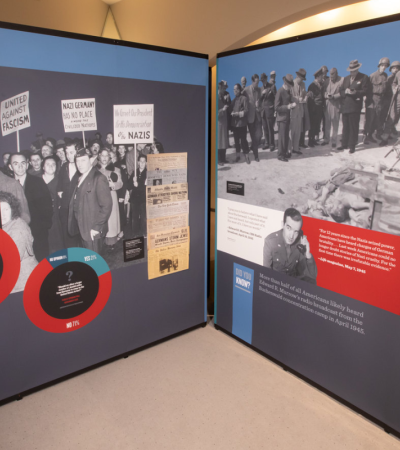On July 5, 1934, the “By the Way” column on Page 2 of the Bulloch Times (Statesboro, Georgia) contained several short blurbs on national news. The first item reported that “holding sway over all other matters” was the sweltering 102-degree heat in the nation’s capital. The second item congratulated U.S. Sen. William E. Borah of Idaho on his 69th birthday. The third blurb expressed dismay at Hitler’s June 30 purge of the Storm Troopers, a Nazi Party paramilitary group.
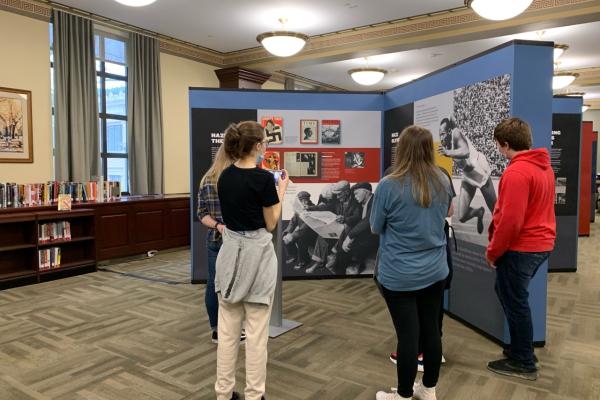
A partial image of the column, now part of the History Unfolded: U.S. Newspapers and the Holocaust database of the United States Holocaust Memorial Museum in Washington, D.C., offers a snapshot into one local U.S. newspaper’s coverage of events unfolding in Europe at the time.
The article was discovered on microfilm at Georgia Southern University Libraries during a History Unfolded workshop in which participants — students, history scholars and community members — searched local newspapers for news and opinion articles about Holocaust-era events and submitted them to the Museum’s national database. The workshop was part of the academic library’s programming to accompany Americans and the Holocaust, a traveling exhibition presented by the Museum and the American Library Association (ALA). The exhibition examines the motives, pressures and fears that shaped Americans’ responses to Nazism, war and genocide in Europe during the 1930s and 1940s.
Americans and the Holocaust is traveling to 50 U.S. public and academic libraries from 2021 to 2023, and the tour has been extended to 50 more libraries from 2024 to 2026. Academic libraries, as well as public libraries, are invited to apply now until October 14, 2023.
Georgia Southern University Libraries, Pennsylvania State University Libraries and University of Mississippi Libraries — all rural academic libraries at universities with multiple campuses — hosted Americans and the Holocaust in late 2021 and early 2022.
Below, librarians who helped organize the exhibition at each of the three universities share some of their program successes and provide insights into how they engaged both their campus and surrounding communities. If you are interested in applying to be part of the new phase of the tour, learn more and apply by October 14, 2023.
Collaborate with faculty
All the libraries reached out in advance — months or as long as a year before the traveling exhibition arrived — to faculty members who taught classes or specialized in areas related to the themes in Americans and the Holocaust. The libraries utilized Museum resources to help faculty incorporate the exhibition into their curriculum, asked for programming ideas, and invited participation by faculty in workshops or on scholarly panels. Some professors had students visit the exhibition as part of a class session; others made it an optional activity.
Autumn M. Johnson, special collections librarian at the Zach S. Henderson Library on Georgia Southern University’s Statesboro campus, initially reached out to just a few faculty. They recommended other professors in disciplines such as history, English, religion, philosophy, political science and public health.
Tara Murray Grove, librarian for Germanic and Slavic languages and literatures at Pennsylvania State University, said the library sent information to faculty “before, during and after the exhibition period” to encourage engagement. Penn State faculty recommended scholars from outside the university to participate in scholarly Zoom panels, with Q-and-A’s moderated by the director of Penn State’s Jewish Studies Program. On-campus faculty hosted film screenings and discussions, including a screening of the 2018 documentary “Who Will Write Our History,” about the Oneg Shabbat archive, a collection of materials and written eyewitness accounts of the Warsaw ghetto compiled by a secret group as a way to document their lives during the Holocaust.
J. Adam Clemons, digital humanities and data visualization librarian at The University of Mississippi’s J.D. Williams Library, said the exhibition was on campus mainly during the school’s winter break from December 2021 through January 2022, so programs involving faculty and students were concentrated at the beginning and end of the exhibition. One history professor developed a course, Americans and the Holocaust, based on the exhibition. When students were about to start the next semester, the library hosted a screening of “Defying the Nazis: The Sharps’ War,” a documentary about a Massachusetts couple who went to Europe to help save Jewish refugees.
The exhibition offered University of Mississippi students minoring in museum studies a unique opportunity to help library staff unpack and assemble Americans and the Holocaust as part of their “Introduction to Museum Practice” class, and to conduct primary source research in the library’s archives for an accompanying exhibition.
Create projects for students
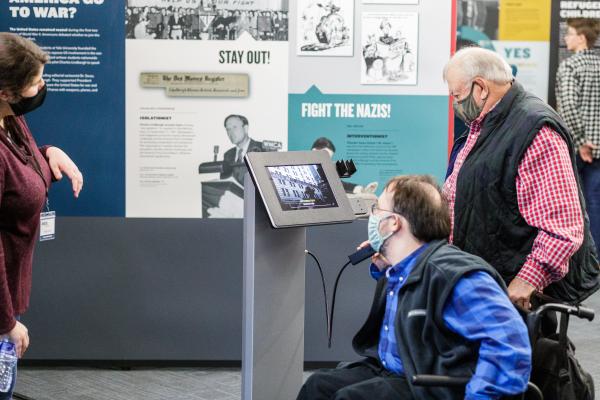
Johnson of Georgia Southern University said her library collaborated with a faculty member to develop a writing internship for the fall semester before the exhibition opened. The intern, who had a personal interest in the Holocaust and literature, was a “tremendous help,” doing most of the work to compile historical Holocaust-era coverage from local newspapers, Johnson said. She contributed as well to writing information panels for a companion exhibition.
The library also enlisted students to serve as docents for the exhibition. During three training sessions, both graduate and undergraduate students, mainly from the university’s public history program, learned how to lead tours. All docents were required to attend three training sessions (five hours), attend the opening reception (1.5 hours), and be available for a minimum of two tours (one hour), representing a minimum commitment of 7.5 hours for each docent.
Student docents had a substantial impact on the programming at Georgia Southern University. A total of 44 tours were scheduled for groups as large as 75, and overall, 357 visitors attended a docent-guided tour during the exhibition, plus 94 visitors who went on a tour during the opening reception.
Develop an accompanying exhibit
The internship and History Unfolded workshops at Georgia Southern University led to a companion online and in-person exhibit, Our Community and the Holocaust. The student intern and workshop participants, Johnson said, “transformed the traveling exhibition’s central question, ‘What did Americans know?’ to ‘What did our campus and greater communities know?’” The resulting exhibit, she said, featured more than 140 local news articles.
Penn State created a companion exhibit, Jewish Histories, that featured primary sources and artists’ books related to Jewish life and culture from the library’s special collections. Artifacts on display included letters from families overseas who wanted to immigrate to the United States in the 1930s and ‘40s to escape persecution, and a map of a Jewish cemetery donated by a local synagogue.
“It was really powerful for visitors to see real handwriting, typed letters and photographs,” Grove said.
The University of Mississippi curated display cases featuring the papers of John Rankin, a Mississippi member of the U.S. House of Representatives from 1921-53 who is quoted in the exhibition and whose papers revealed antisemitic and xenophobic views he held; and James Eastland, a U.S. senator from Mississippi from 1941-78 with anti-Jewish and anti-African American views. These displays reinforced for visitors the range of beliefs and attitudes present in the U.S. at the time and engaged visitors in thinking about the motives and pressures influencing Americans' responses to the plight of Jews abroad.
Create opportunities for reflection
Georgia Southern University hosted on-campus “Caffeine & Zine” workshops at coffee shops in the library where participants created zines or creative collages that addressed the exhibition’s themes.
“These sessions gave people an outlet to respond, in a more creative, low-pressure way,” Johnson said. “We talked about the historic precedence of artwork like zines in the Warsaw ghetto and made the connection to responses to social justice issues today.”
Georgia Southern also created a React Board with cards that visitors could write on in response to the prompt: “What conditions might motivate people to help each other? What conditions might make people turn away?”
The Humanities Institute at Penn State offered the exhibition as a community partnership for undergraduate students in a public humanities course. Two students collaborated to produce a podcast about the exhibition for their final project.
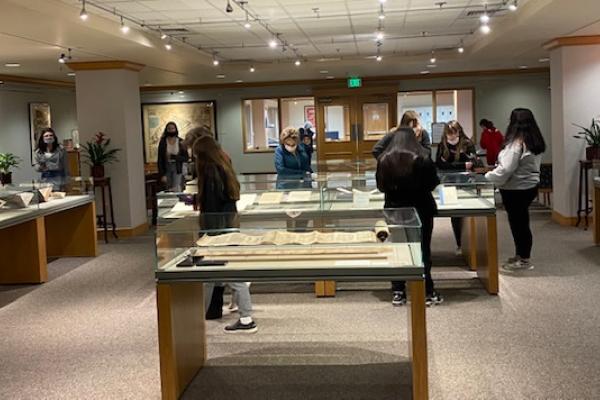
Partner with community organizations, schools, and libraries
The local public library was a “key partner” in reaching out to the local community around Penn State, Grove said. The month before the university hosted Americans and the Holocaust, a nearby local public library hosted two exhibition-related book discussions and partnered with a community arts organization to curate a display of artists’ reactions to the exhibition’s themes.
Glendale Junior/Senior High School organized a field trip to view the exhibition. “This was a new partnership,” Grove said. “While the students were here, we provided some education about college libraries and encouraged them to visit the Penn State campus and library closest to them.”
All three libraries invited members of local organizations, such as synagogues, churches, service groups, and public and private schools, to tour the exhibition; word-of-mouth from those groups to others in the community was a key source of publicity.
Because the exhibition was on display at the University of Mississippi during winter break, the library focused most of its outreach on the wider community. Local Jewish organizations and Friends of the Library groups were helpful in spreading the word, Clemons said. The library also hosted a pre-exhibition, full-day workshop for teachers in grades 7-12 to introduce them to the exhibition’s themes and how to incorporate lessons about the Holocaust into their curriculum, whether or not they planned to visit the exhibition on a field trip.
At Georgia Southern University, library staff guided participants during History Unfolded workshops to search for Holocaust-related stories in regional newspapers, including historical Black news publications. One workshop was a collaboration with Savannah State University, an HBCU (historically Black college or university), as part of a Black Heritage Month celebration. Comparing media coverage was particularly interesting, Johnson said, because reporting was very different between publications.
The Savannah Morning News, geared toward a “whiter audience,” Johnson said, “had lots of national and Associated Press international coverage, with fewer op-eds.” The Savannah Tribune, a newspaper for Black readers, featured stories and op-ed pieces that “placed more emphasis on the shared experience of being marginalized, and more personalized experiences of soldiers.”
Make local connections
The University of Mississippi Libraries organized programming that explored antisemitism as a local issue. For example, a historian who spoke at an opening reception talked about how Jewish Americans in the South responded to the Holocaust, and connected activism during the World War II years to the Civil Rights Movement later on.
“I think people were really surprised to learn that Jewish Americans in the South were not one block who shared similar thoughts about war, the Holocaust and African Americans,” Clemons said. “The Jewish American experience in the South was very complex.”
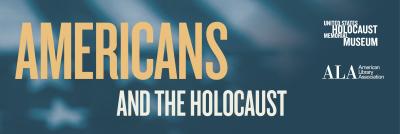
All three librarians said the traveling exhibition’s effects lasted long after the six weeks it was on display.
Clemons said the relationships he developed with colleagues were invaluable. “I wouldn’t have the relationship with the person who heads up our museum studies program without this experience,” Clemons said.
Johnson said the cross-disciplinary team of people from different departments at Georgia Southern University who worked to present the exhibition even won the school’s annual Team Award for their collaborative efforts.
The libraries have also maintained online guides to resources about the Holocaust for ongoing research.
Clemons said that anecdotally, talking to faculty, students, library colleagues and visitors who came to see the exhibition, he learned that “people tend to think of the Holocaust within the context of Nazi Germany and Europe, as something distant and far away, with clear perpetrators and victims. This traveling exhibition challenged people to think about how news was conveyed and covered during the war, and what Americans did, on a local level.”

